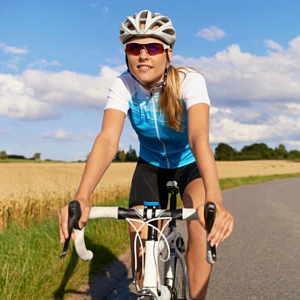Bike Safety

There are many benefits to riding a bike. It is a fun and physically low impact way to incorporate exercise into your everyday life. But as beneficial as bicycling can be, it can also be quite dangerous if you don't take the proper safety precautions.
According to the National Highway Traffic and Safety Administration, there were an estimated 45,000 bicyclist injuries in 2015. Here are some safety tips to help keep your bike rides injury-free.
Basic Tips
It should be obvious to always wear a helmet, but it's just as important to make sure it fits you properly and is approved by the Consumer Product Safety Commission. It shouldn't be too big or too small, and you shouldn't wear anything underneath the helmet. A helmet is crucial because it will help protect your head from brain injuries in case of a crash.
After you get your helmet on, see if your bicycle fits you. To figure it out, stand over your bike to see if the seat is the correct height. You'll know it's right if you can just barely touch the ground when you are sitting in your seat. Having a seat that is too low will keep you from fully extending your legs when you're pedaling. You know your seat is too high if you have trouble reaching the pedals and if the handlebars are lower than your seat. Adjust your seat as necessary before you begin your ride.
Finally, before you start riding, make sure that your tires and brakes are working properly, and keep both of your hands on the handlebars as often as you can when you're on your bike.
On the Road
Don't forget to obey all traffic laws when you are riding your bike on the road. Generally, riders feel safer father away from traffic. If there is a bike lane or path, make sure you are staying in that lane. You would think that riding a bike on sidewalks is safer, but in truth, it isn't always the best idea. You have to watch out for pedestrians, and in residential areas, a driver might not expect to see you when they are backing out of their driveway and could hit you. Also, try not to ride between cars when you're on your bike, and make sure you signal noticeably and look carefully before making any moves on the road.
For Kids
Kids need to learn how to ride their bikes responsibly too, and you're just the one to teach them! Always have them wear helmets and make sure they have proper footwear for the activity. Tennis shoes with tied shoe laces are great because they don't slip off feet easily. Children younger than 10 years old should not ride on roads with traffic. It's always good to supervise younger children to prevent any falls and to make sure they are riding in safe places. Tell your kids to ride only one person per bike, and encourage them to keep both hands on the handlebars at all times, unless signaling.
Bike crashes involving cars usually result in the most serious injuries, but crashes with objects and people can give you awful injuries too. Keeping the above safety tips in mind could help prevent some of those injuries.
Now that you have been reminded of some important safety tips, have a fun ride!
